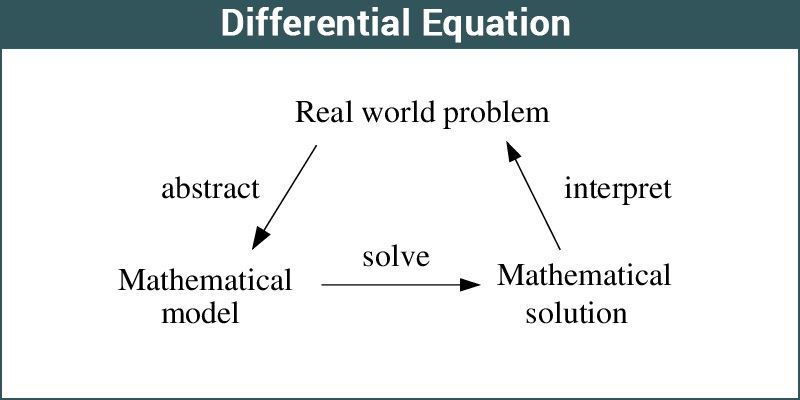Differential Equations
In Mathematics, a differential equation is an equation that contains one or more functions with its derivatives. The derivatives of the function define the rate of change of a function at a point. It is mainly used in fields such as physics, engineering, biology and so on. The primary purpose of the differential equation is the study of solutions that satisfy the equations and the properties of the solutions. Learn how to solve differential equations here.
One of the easiest ways to solve the differential equation is by using explicit formulas. In this article, let us discuss the definition, types, methods to solve the differential equation, order and degree of the differential equation, ordinary differential equations with real-word examples and a solved problem.
| Table of Contents: |
Differential Equation Definition
A differential equation is an equation which contains one or more terms and the derivatives of one variable (i.e., dependent variable) with respect to the other variable (i.e., independent variable)
dy/dx = f(x)
Here “x” is an independent variable and “y” is a dependent variable
For example, dy/dx = 5x
A differential equation contains derivatives which are either partial derivatives or ordinary derivatives. The derivative represents a rate of change, and the differential equation describes a relationship between the quantity that is continuously varying with respect to the change in another quantity. There are a lot of differential equations formulas to find the solution of the derivatives.
Order of Differential Equation
The order of the differential equation is the order of the highest order derivative present in the equation. Here some examples for different orders of the differential equation are given.
- dy/dx = 3x + 2 , The order of the equation is 1
- (d2y/dx2)+ 2 (dy/dx)+y = 0. The order is 2
- (dy/dt)+y = kt. The order is 1
First Order Differential Equation
You can see in the first example, it is a first-order differential equation which has degree equal to 1. All the linear equations in the form of derivatives are in the first order. It has only the first derivative such as dy/dx, where x and y are the two variables and is represented as:
dy/dx = f(x, y) = y’
Second-Order Differential Equation
The equation which includes the second-order derivative is the second-order differential equation. It is represented as;
d/dx(dy/dx) = d2y/dx2 = f”(x) = y”
Degree of Differential Equation
The degree of the differential equation is the power of the highest order derivative, where the original equation is represented in the form of a polynomial equation in derivatives such as y’,y”, y”’, and so on.
Suppose (d2y/dx2)+ 2 (dy/dx)+y = 0 is a differential equation, so the degree of this equation here is 1. See some more examples here:
- dy/dx + 1 = 0, degree is 1
- (y”’)3 + 3y” + 6y’ – 12 = 0, degree is 3
- (dy/dx) + cos(dy/dx) = 0; it is not a polynomial equation in y′ and the degree of such a differential equation can not be defined.
Note:
Order and degree (if defined) of a differential equation are always positive integers.
Types of Differential Equations
Differential equations can be divided into several types namely
- Ordinary Differential Equations
- Partial Differential Equations
- Linear Differential Equations
- Nonlinear differential equations
- Homogeneous Differential Equations
- Nonhomogeneous Differential Equations
Ordinary Differential Equation
An ordinary differential equation involves function and its derivatives. It contains only one independent variable and one or more of its derivatives with respect to the variable.
The order of ordinary differential equations is defined as the order of the highest derivative that occurs in the equation. The general form of n-th order ODE is given as
Differential Equations Solutions
A function that satisfies the given differential equation is called its solution. The solution that contains as many arbitrary constants as the order of the differential equation is called a general solution. The solution free from arbitrary constants is called a particular solution. There exist two methods to find the solution of the differential equation.
- Separation of variables
- Integrating factor
Differential Equation

Separation of the variable is done when the differential equation can be written in the form of dy/dx = f(y)g(x) where f is the function of y only and g is the function of x only. Taking an initial condition, rewrite this problem as 1/f(y)dy= g(x)dx and then integrate on both sides.
Also, check: Solve Separable Differential Equations
Integrating factor technique is used when the differential equation is of the form dy/dx + p(x)y = q(x) where p and q are both the functions of x only.
First-order differential equation is of the form y’+ P(x)y = Q(x). where P and Q are both functions of x and the first derivative of y. The higher-order differential equation is an equation that contains derivatives of an unknown function which can be either a partial or ordinary derivative. It can be represented in any order.
We also provide a differential equation solver to find the solutions for related problems.
Applications
Differential equations have several applications in different fields such as applied mathematics, science, and engineering. Apart from the technical applications, they are also used in solving many real life problems. Let us see some differential equation applications in real-time.
1) Differential equations describe various exponential growths and decays.
2) They are also used to describe the change in return on investment over time.
3) They are used in the field of medical science for modelling cancer growth or the spread of disease in the body.
4) Movement of electricity can also be described with the help of it.
5) They help economists in finding optimum investment strategies.
6) The motion of waves or a pendulum can also be described using these equations.
The various other applications in engineering are: heat conduction analysis, in physics it can be used to understand the motion of waves. The ordinary differential equation can be utilized as an application in the engineering field for finding the relationship between various parts of the bridge.
Now, go through the differential equations examples in real-life applications .
Linear Differential Equations Real World Example
To understand Differential equations, let us consider this simple example. Have you ever thought about why a hot cup of coffee cools down when kept under normal conditions? According to Newton, cooling of a hot body is proportional to the temperature difference between its temperature T and the temperature T0 of its surrounding. This statement in terms of mathematics can be written as:
dT/dt ∝ (T – T0)…………(1)
This is the form of a linear differential equation.
Introducing a proportionality constant k, the above equation can be written as:
dT/dt = k(T – T0) …………(2)
Here, T is the temperature of the body and t is the time,
T0 is the temperature of the surrounding,
dT/dt is the rate of cooling of the body

Eg: dy/dx = 3x
Here, the differential equation contains a derivative that involves a variable (dependent variable, y) w.r.t another variable (independent variable, x). The types of differential equations are :
1. An ordinary differential equation contains one independent variable and its derivatives. It is frequently called ODE. The general definition of the ordinary differential equation is of the form: Given an F, a function os x and y and derivative of y, we have
F(x, y, y’ …..y^(n1)) = y (n) is an explicit ordinary differential equation of order n.
2. Partial differential equation that contains one or more independent variables.
Solved problem
Question:
Verify that the function y = e-3x is a solution to the differential equation \(\frac{d^2y}{dx^2}~ + ~\frac{dy}{dx} ~-~ 6y\) = \(0\).
Solution:
The function given is \(y\) = \(e^{-3x}\). We differentiate both the sides of the equation with respect to \(x\),
\(\frac{dy}{dx}\) = \(- 3 e^{-3x}\)
Now we again differentiate the above equation with respect to x,
\(\frac{d^2y}{dx^2}\) = \(9 e^{-3x}\)
We substitute the values of \(\frac{dy}{dx}, \frac{d^2y}{dx^2}\) and \(y\) in the differential equation given in the question,
On left hand side we get, LHS = 9e-3x + (-3e-3x) – 6e-3x
= 9e-3x – 9e-3x = 0 (which is equal to RHS)
Therefore, the given function is a solution to the given differential equation.
Differential Equations Practice Questions
- Find the order and degree, if defined, for the differential equation (dy/dx) – sin x = 0.
- Verify that the function y = a cos x + b sin x, where, a, b ∈ R is a solution of the differential equation (d2y/dx2) + y = 0.
- Verify that the function y = Ax, where, a, b ∈ R is a solution of the differential equation xy’ = y (x ≠ 0)
To gain a better understanding of this topic, register with BYJU’S- The Learning App and also watch interactive videos to learn with ease.
Frequently Asked Questions on Differential Equations
What is differential Equation?
In Mathematics, a differential equation is an equation with one or more derivatives of a function. The derivative of the function is given by dy/dx. In other words, it is defined as the equation that contains derivatives of one or more dependent variables with respect to one or more independent variables.
Mention the various types of differential equations.
The different types of differential equations are:
Ordinary Differential Equations
Partial Differential Equations
Homogeneous Differential Equations
Non-homogeneous Differential Equations
Linear Differential Equations
Nonlinear Differential Equations
What is the order of the differential Equation?
The order of the highest order derivative present in the differential equation is called the order of the equation. If the order of the differential equation is 1, then it is called the first order. If the order of the equation is 2, then it is called a second-order, and so on.
What is the use of a differential equation?
The main purpose of the differential equation is to compute the function over its entire domain. It is used to describe the exponential growth or decay over time. It has the ability to predict the world around us. It is widely used in various fields such as Physics, Chemistry, Biology, Economics and so on.